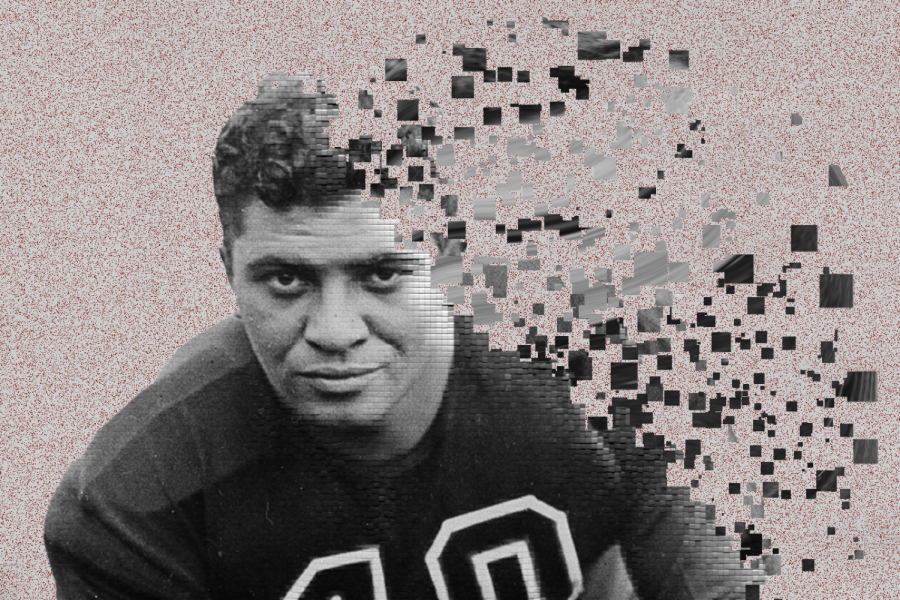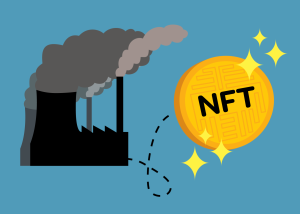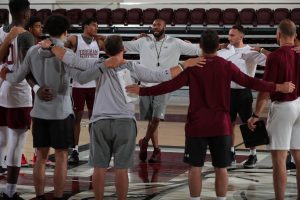For Sale: Lombardi NFTs, Never Bought
A new effort to enter an emerging market takes a Fordham spin
With all the hype surrounding NFTs, Fordham University recently decided to enter the market.
February 28, 2022
Non-fungible tokens (NFTs) have taken the online world by storm. If you are on the internet, you will likely have seen photographers, cryptocurrency experts and avid entrepreneurs all rallying around weird-looking monkeys in hoodies and gold chains.
Recently, Fordham University has “minted,” or published, their own line of themed NFTs based on Fordham football star Vince Lombardi, Fordham College ’37, and his illustrious college career. Although NFTs are gaining popularity, many people still know little about them.
What are NFTs?
An NFT is a digital asset stored on a blockchain. It is “non-fungible,” meaning that the token is unique and cannot be replicated by any other item. It belongs to a specific user, and the security features of the blockchain allow someone to prove ownership of the token. The NFT can be bought and sold and functions much like a commodity on a typical supply-and-demand market. Unlike other commodities, NFTs have a twist to them: They are entirely digital. Often, NFTs are images, but they can also be audio or video clips.
Because NFTs exist on a blockchain with a public ledger accessible to all, one can prove ownership of a digital item.
Blockchain is a technology that has been typically associated with cryptocurrency. Blockchains are powerful tools for making anonymous, secure transactions.
Because NFTs exist on a blockchain with a public ledger accessible to all, one can prove ownership of a digital item. A certificate is required to prove that the digital collectible you own is authentic. This creates “digital scarcity.” While anyone can screenshot a picture on the internet, being the authentic owner of something means a lot, and this is where the value of NFTs is found.
Most NFTs are on the Ethereum blockchain. Differing from other popular cryptocurrencies such as Bitcoin, Ethereum’s blockchain is multipurpose and is perfectly suited for this emerging market.
Prospective buyers can make offers on 38 separate NFTs in the Lombardi collection.
One of the most popular NFTs currently is called the Bored Ape series. The series features portraits of apes posing with various items and expressions. Their value as collectibles is often confusing; they don’t fall under any category of traditionally valuable art. Due to their “digital scarcity,” they can often sell for just as much or more than some of the world’s most expensive paintings. Another very popular NFT collection is called CryptoPunks and its current valuation is $5.4 billion.
Because of the high return on many of these NFTs — in 2017, a CryptoPunk series collectible sold for $171 million — many smaller parties have ventured into the field looking for profit. Some photographers, such as New York City based Dave Krugman, have published their work as NFTs.
With all the hype surrounding NFTs, Fordham University recently decided to enter the market. The university “minted” a collection of Lombardi-themed NFTs on Feb. 23.
Fordham Athletics’ Contribution
Last summer, Fordham Athletics announced a partnership with Crescite Innovation Corporation. Crescite is the company responsible for minting the NFTs Fordham Athletics put up for auction. It also sits on the Council for Inclusive Capitalism with the Vatican. According to their website, the council is a group of business leaders who seek to make a more inclusive world, inspired by the teachings of Pope Francis. The Lombardi NFTs exist on the Ethereum blockchain, despite the Crescite company’s claimed desire on its website to create the “Laudato Si” blockchain with renewable energy sources, a new technology that they claim would reflect the values of the Catholic church.
Currently, prospective buyers can make offers on 38 separate NFTs in the Lombardi collection. Originally, the NFTs were only available through auction, with a minimum starting bid of 0.4 “wrapped Ethereum,” which is worth about $1,100 at the time of writing. Since Feb. 17, none of the items have been auctioned or sold to any buyers.
The collection includes images and animated graphical representations of memorabilia related to Lombardi’s career at Fordham, both as a football player and coach. Some of the images include photographs of Lombardi paintings, while others are shots of physical items. These include images of Lombardi’s locker, filled with memorabilia like his original jersey. An image of the jersey itself is also being sold as an NFT. Some of the animated images are plaques and photographs commemorating Lombardi’s time at Fordham.
All of the NFTs include various bonus items and services associated with the NFT being purchased. For example, the description of the locker states that its buyer will receive a “personalized tour” of the locker. Whoever buys the image of Lombardi’s jersey will receive a current Fordham football jersey signed by Ed Kull, director of intercollegiate athletics, and Joe Conlin, football head coach. Each NFT will come with various other benefits, including a Fordham hat, a letter from Kull and a raffle entry for seats behind the end zone at a Fordham football game.
Fordham Athletics’ efforts have yet to bear fruit. As of writing, the collection’s OpenSea page indicates that no bids have been placed. This is not the first time that Lombardi’s name and legacy have been utilized by Fordham Athletics. The fieldhouse built in 1976 to supplement the Rose Hill Gymnasium was named in his honor. Fordham Athletics also opened a football suite named after the most well known of the “Seven Blocks of Granite,” a nickname given to Lombardi and six of his teammates during his playing career. Donations requested for the suite were substantial, with rewards being handed out starting at $5,000.
As the basketball season approaches its conclusion, the lengthy baseball season begins and the spring semester reaches its halfway point, Fordham Athletics is in full stride. The NFT collection represents another venture that the administration is using to bolster financial engagement, particularly in an emerging market.
















